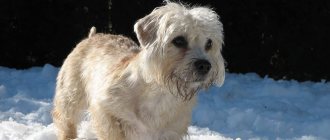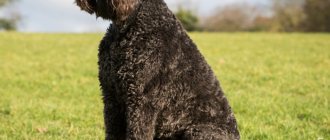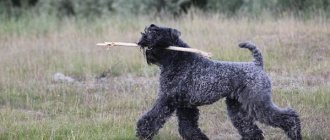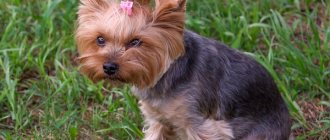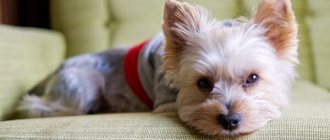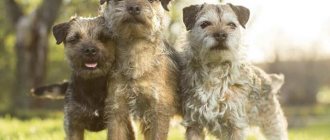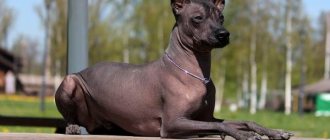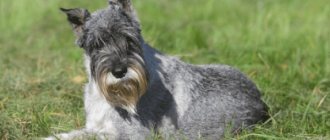The Dandie Dinmont Terrier is one of the oldest and most unique terrier breeds. It is the only dog breed in the world named after the fictional character, Scottish hunter Dandy Dinmont, from Sir Walter Scott's 1814 novel Guy Mannering. Considered a rare breed, regularly ranking low on registration lists in both the United States and the United Kingdom.
Breed traits
Breed traits (on a 5-point scale)
| Dandie Dinmont Terrier | |||
| Activity | in the house | 4 | |
| on the street | 4 | ||
| Obedience | training | 2 | |
| strangers | 2.7 | ||
| Domination | in family | 2 | |
| over dogs | 4 | ||
| Defending your territory | from people | 3 | |
| from dogs | 4 | ||
| Sociability | in family | 3 | |
| with strangers | 2 | ||
| with dogs | 2 | ||
| Concentration | in family | 1.5 | |
| in front of strangers | 2 | ||
| with dogs | 2.3 | ||
| Aggressiveness | in family | 1 | |
| to strangers | 2 | ||
| to the dogs | 2 | ||
| to cats | 3 | ||
| Family behavior | calmness | 3.5 | |
| demand for affection | 4.9 | ||
| excitability | 4 | ||
| playfulness | 4 | ||
| excessive barking | 2 | ||
| behavioral breakdowns | 2.5 | ||
| Tolerance for children | up to 4 years | 4 | |
| over 4 years old | 4.5 | ||
| Institutional use | watchman | 4 | |
| bodyguard | 1.3 | ||
This breed is often compared to the following dog breeds: Beagle, Jack Russell Terrier, Dalmatian, Papillon, Airedale Terrier.
The photo shows what Dandie Dinmont Terriers look like:
Price review
A distinctive feature of the breed is the change in color of the puppy as it grows. As a rule, offspring are born in darker colors. Their color brightens by 8 months and only at the age of 3 years the color palette is fully formed and consolidated. Therefore, do not panic if the breeder offers you puppies that are not mustard color, which is the standard color.
The breed is not common in our country, but official nurseries are represented in large cities. The cost of a puppy depends on the availability of documents and the merits of its parents at exhibitions. The average price varies between 1100-1800 dollars.
Breed characteristics
This small shaggy dog with an elongated body, like a dachshund, was bred in Scotland to hunt rodents. She still has hunting instincts, although now she is bred as a decorative or companion dog.
| Options | Characteristic |
| breed name | Dandie Dinmont Terrier |
| a country | Great Britain |
| breed group | terriers |
| application | hunter, companion, decorative dog |
| life expectancy | 12-15 years |
| height | 20-28 cm |
| weight | 8-11 kg |
| activity | high |
| intelligence | high |
pros
Due to their small size, Dandie Dinmont Terriers are suitable for apartment living. These dogs are unpretentious, they do not need complex care or expensive food. They have the following advantages:
- devoted, faithful;
- good-natured, do not show aggression;
- get along well with children;
- get along with other pets;
- the wool does not smell, sheds little;
- they are not imposed upon, they can independently find something to do;
- They have a stable psyche and easily adapt to changes in environment.
Minuses
Dogs of this breed are very active and playful. They need physical activity and mandatory walking. Therefore, the breed is not suitable for everyone. Several disadvantages in the character of these terriers can lead to problems in maintenance:
- obey only one master;
- bark a lot;
- can be stubborn;
- love to play pranks;
- conflict with other dogs.
Health
A relatively healthy breed with an average lifespan of 11 to 13 years. There are very few breeders of this dog, and almost all of them are dedicated to allowing only the healthiest animals to breed.
Additionally, the breed has always been rare and has not been subject to the questionable mass breeding practices that have plagued some breeds. However, the small population also makes it very difficult to accurately assess what dangers a breed is exposed to, since even a few cases of the disease will appear to be statistically anomalous in the general population.
One of the problems this breed most often suffers from is back problems. A long back is vulnerable to slipped discs, fractures, chronic pain and many other problems. Due to the breed's elongated body, it can have back problems, especially with the intervertebral discs in the dog's back.
These discs can sometimes slip out of place, leading to a herniated disc. Symptoms depend on what part of the dog's back is affected; these may include paralysis with loss of bladder and bowel control in the worst cases.
It is important to be careful when playing with these dogs to prevent injury. It is extremely important to carefully monitor the diet and weight of these dogs, as overweight dogs are significantly more likely to develop back problems than dogs of a healthy weight.
History of the origin of the Dandie Dinmont Terrier breed
This is an ancient breed; the first mentions of it date back to the 16th century. She was bred in Scotland on the basis of Scottish terriers. Skye terriers and Bedlington terriers took part in the selection. These were small dogs, fast and hardy. They were started by farmers and gypsies. They helped exterminate rodents and warned owners about the approach of uninvited guests. Their small size made them easy to maintain.
Breeders tried to use selective breeding to obtain a small, hardy dog for burrow hunting. Representatives of the new breed hunted badgers, otters, rats, and could even cope with a fox or marten. They were fearless and quick to react. The breed became popular after the publication of Walter Scott's novel Guy Mannering. The main character kept a whole pack of these dogs. The name Dandie Dinmont Terrier comes from his name.
By the end of the 19th century, the breed became very popular. These unusual terriers were kept by aristocrats and even Queen Victoria. A breed club was created and the breed spread throughout the world. Then she was officially recognized. After World War II, the number of dogs decreased. Now the Dandie Dinmont Terrier breed is considered rare.
Appearance
Dandie Dinmont dogs cannot be confused with other terriers. They have a disproportionate physique: the body is elongated, the limbs are short. Height does not exceed 28 cm, but weight can reach 11 kg. Another characteristic feature of its appearance is the fluffy cap on the top of its head.
Head
The head is quite large. The forehead is wide, the transition to the muzzle is sharply defined. The jaws are powerful and have a scissor bite. The lobe is large, black. The eyes are large, slightly protruding, and set wide apart. The iris is dark brown. Ears are drooping.
Frame
The neck is short and muscular. The body is elongated. The chest is wide and deep, the back line is curved. The tail is set high and of medium length. It is smooth, can rise vertically, but never bends or curls into a ring.
Limbs
The limbs are short and muscular. The hind ones are slightly longer than the front ones. The limbs are widely spaced. The hock joints are set low. The paws are compact, the toes are collected. The movements are sweeping and smooth.
Coat and color
The coat is thick and of medium length. It is hard on the body and softer on the head. Forms a mustache, beard, cap, and long hair on the belly. There is a dense dense undercoat.
Two main colors are common: mustard and salt and pepper. The first is all shades of red, red and brown. The second is a black and silver color. The cap is necessarily lighter than the rest of the body. There may be white spots on the head, chest, and paws.
Photos complement the description of the appearance:
Appearance
According to the standard, dogs of this breed should be no higher than 29 cm at the withers and weigh up to 10 kg. Their head is large with a convex forehead. The skull visually tapers towards the eyes. The nose is black.
Pets have a scissor bite. The jaws are well developed and strong, closing tightly. The canines are large for such a small dog.
The eyes are wide apart. They are large and convex. Most often nutty.
The ears are low set and hang down freely, lying close to the cheeks. Their color is no different from the pigmentation of the body.
The dogs' chest is developed and wide. The ribs have a rounded shape. If you follow the line of the back, it will go down.
Pets have a short tail. It bends in an arc, but this does not mean that the vertebrae are curved.
The legs are short and strong. The shoulder blades are set obliquely. The hips have well-developed muscles and the hind legs are higher than the front legs. Dogs of this breed move gracefully and smoothly.
The outer coat of pets is hard, and the undercoat is soft. Pepper or mustard colors.
Characteristics of the Dandie Dinmont Terrier
These are very friendly dogs, devoid of aggression towards humans. They are cheerful and sociable. They become a devoted friend and faithful companion for the owner. These are curious, fearless dogs. They are wary of strangers and warn of their approach with loud barks.
These terriers are cheerful, playful, and love to play pranks. They are friendly, affectionate and patient with children. But they do not like familiarity and rudeness. They get along with other pets if they grew up together. Due to their hunting instincts, they do not tolerate rodents. And they can get into fights with dogs of the same sex.
The Dinmont Terrier has the following character traits:
- friendliness;
- intelligence;
- curiosity;
- cheerfulness;
- sociability;
- fearlessness;
- stubbornness;
- independence.
Education and training
These terriers are smart, quick-witted, but have an independent character. In order for such a dog to obey, you need to find the right approach to him. The owner must gain authority, then the pet will obey, understand him perfectly and try to please.
From the first days of arrival in the house, the puppy must be taught the rules of behavior. He must respond to his name, know his place, and be able to walk on a leash. Basic commands that need to be taught immediately:
- it is forbidden;
- ugh;
- sit;
- stand;
- near;
- place.
Training must be consistent and regular. It should be taken into account that these terriers do not tolerate monotony; if they get bored, they can run away. The owner needs to be patient, firm, but not rude. It is better not to use physical punishment or yell at the dog. Treats and affection are used for encouragement.
Timely socialization is very important for representatives of this breed. It is recommended to take your puppy to dog parks so that he will be calmer around other dogs.
Temperament
The breed is hardy but usually friendly and suitable for older children. He will make both a good companion and a guard dog, but is one of the most docile terrier breeds; they are usually quite undemanding towards their owners. However, they are known for their ability to dig large holes in a short period of time. They can be trained to be good with cats, but should not be trusted with smaller animals such as hamsters or rats. They are described as "very wild animals" as they tend to challenge other animals, including foxes and in some cases other dogs.
Maintenance and care
The Dandie Dinmont Terrier must be kept in a house or apartment. Although this dog is unpretentious and can live in a warm booth, it requires constant contact with a person, without whom he will be sad.
This terrier is a hunting dog, so daily walking is necessary. You cannot, like other decorative dogs, be trained to use the toilet in a diaper. You need to take him outside twice a day. You can walk for 30-40 minutes, but with active games and jogging. Due to the peculiarities of their body structure, it is advisable for these terriers not to often go down stairs or jump - they may develop spinal pathologies.
Hygiene procedures
This terrier requires the same hygiene procedures as other dogs:
- brush the coat with a stiff brush every 1-2 days;
- regularly trim your mustache and beard, shorten the hairs between your fingers and ears, get a decorative haircut 2-3 times a year;
- bathe as needed, but not more than once every 2 months;
- inspect and wipe your eyes daily;
- Clean your ears 2 times a week;
- trim nails every month;
- To care for your teeth, you can use a special toothpaste or chewable treats.
Nutrition
You can feed this terrier with prepared food or natural food. He does not need a lot of food, but it must be complete and provide the dog with all the necessary nutrients. The puppy is fed 4-7 times a day depending on age. The number of feedings decreases gradually. By the age of one year, the dog is switched to two meals a day. You cannot overfeed, Dinmont Terriers are prone to obesity.
When choosing ready-made food, you should give preference to brands of at least premium class. Veterinarians recommend giving your pet canned food from the same manufacturer in addition to dry granules.
With natural feeding, the pet's diet should consist of lean meat and offal. They are supplemented with cereals and vegetables. It is useful to give fermented milk products, sea fish, eggs. Smoked meats, sweets, confectionery, and tubular bones are contraindicated for dogs. It is better not to give food from your table or canned food.
Health
These dogs live 12-15 years. With good care and regular preventive examinations by a veterinarian, they remain active into old age. The main problem for this breed is spinal pathology and injury. This is due to the length of the back. Also, due to the peculiarities of the body structure, bitches often require assistance during childbirth or a caesarean section. These dogs also have the following diseases:
- glaucoma;
- epilepsy;
- diseases of the digestive system;
- joint pathologies.
Training
The animal is perfectly trainable, but under a strict and authoritarian training regime it will show dissatisfaction and stubbornness. Training should begin from the first days of birth or acquisition. It is extremely important to teach your dog to relieve himself in a separate place. The training process should be fun and varied.
Important! You need to walk your dog once or twice a day. A muzzle is not required in crowded places.
How to buy a Dandie Dinmont Terrier puppy
To buy a purebred terrier, you need to contact a nursery or a breeder who breeds this breed. There are few of them in Russia, but you can find them. The price of a puppy starts from 25 thousand rubles.
Before purchasing, it is recommended to get acquainted with the breeder, the living conditions of the animals, and the behavior of the mother. You need to study documents and veterinary certificates. Puppies of this terrier are born dark, and the color does not develop immediately. But they should have short legs, long hanging ears, and an elongated body.
It is recommended to choose a medium-sized, active and cheerful puppy. The fact that he is healthy is indicated by smooth fur, clear eyes, and a cold nose. He should be well-fed, but with a soft, not bloated tummy.
The photo shows what the puppies should look like:
The video complements the description of the breed:
Video: Dandie Dinmont Terrier. Breed characteristics, care
Video: Dandie Dinmont Terrier. Pros and cons, price, how to choose, facts, care, history
The Dandie Dinmont Terrier is a cheerful and active dog. An ideal pet for a family with children or for an active single person. She is cheerful, good-natured, affectionate. In response to attention and care, he will give you a good mood and his devotion.
